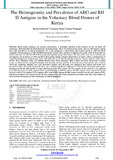The Heterogeneity and Prevalence of ABO and RH D Antigens in the Voluntary Blood Donors of Kenya

View/
Date
2017-09Author
Githiomi, R.
Muna, Kennedy K.
Waiganjo, N.
Metadata
Show full item recordAbstract
Blood groups (antigens) are proteins, glycoproteins or glycolipids inherited surface markers on the red blood cell membranes, which determine the blood phenotypes of human beings. There are 36 blood group systems with over 300 antigens. Among them, ABO and Rh are of clinical significance. For a safe transfusion, a blood donor and recipient should be ABO and Rh D compatible. The heterogeneity of ABO and RhD blood groups systems shows variations in different parts of the world. In Kenya, there is limited study done on ABO and Rh D blood groups heterogeneity among blood donors. The aim of this study was to determine the heterogeneity and prevalence of ABO and Rh D blood groups among voluntary blood donors in Kenya, which is fundamental for compelling management of blood bank stocks. The study sites were, Nairobi, Mombasa, Kisumu, Nakuru, Eldoret, Embu, Meru, Garrisa, Nyeri, Machakos, Thika, Voi, Malindi, Kericho, Kisii, Narok, Bungoma, Kitale, Lodwar and Busia. The presence of blood groups was determined by serological techniques both microtitre and tube methods. Commercial monoclonal antisera (anti-A, anti-B, anti-D and Antihuman globulin) were used. Descriptive statistics and Chi-square were applied in data analysis and results were presented in tables. The results showed that there was a statistical significance difference p< 0.01 between the positive and negative blood types in both the ABO and Rh D systems. Blood group O (51.75%); positive (46.75%), negative (3.5%), weak D (1 .5%), followed by A (24.25%), positive (23.25%), negative (0.5%), weak D (0.25%). B (18.75%); positive (17.25%), negative (1%), weak D (0.25%) and the least is AB at 5.5%; positive (5.5%), negative (0%), weak D (0%). Among the RhD system, D positive was the most common (93%), followed by D negative (5%) and weak D was the least common (2%). This study recommends an extended study with a large sample size and to include heterogeneity of other blood groups of clinical significance.
URI
https://www.semanticscholar.org/paper/The-Heterogeneity-and-Prevalence-of-ABO-and-RH-D-in-Githiomi-Muna/c40bee346e0b75b262e6717f0f252b699e44750ahttp://hdl.handle.net/123456789/4578
